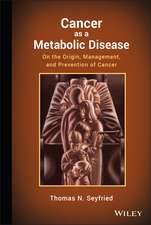Ovarian Cancer 3
Editat de Frank Sharp, Peter Mason, Tony Blackett, Jonathan Bereken Limba Engleză Paperback – 10 mai 2012
Preț: 381.35 lei
Preț vechi: 401.42 lei
-5% Nou
Puncte Express: 572
Preț estimativ în valută:
72.98€ • 75.40$ • 60.70£
72.98€ • 75.40$ • 60.70£
Carte tipărită la comandă
Livrare economică 19 martie-02 aprilie
Preluare comenzi: 021 569.72.76
Specificații
ISBN-13: 9781475701388
ISBN-10: 1475701381
Pagini: 412
Ilustrații: 390 p. 76 illus.
Dimensiuni: 189 x 246 x 22 mm
Greutate: 0.73 kg
Ediția:1995
Editura: Springer Us
Colecția Springer
Locul publicării:New York, NY, United States
ISBN-10: 1475701381
Pagini: 412
Ilustrații: 390 p. 76 illus.
Dimensiuni: 189 x 246 x 22 mm
Greutate: 0.73 kg
Ediția:1995
Editura: Springer Us
Colecția Springer
Locul publicării:New York, NY, United States
Public țintă
ResearchCuprins
One Genetics Of Ovarian Cancer.- 1 The genetic epidemiology of ovarian cancer.- 2 Genetic epidemiology of familial ovarian cancer in Utah.- 3 Isolating tumour suppressor genes relevant to ovarian carcinoma — the role of loss of heterozygosity.- 4 The BRCAl gene in sporadic breast and ovarian cancer.- 5 Allele losses on chromosome 17 in ovarian tumours.- 6 Cloning and molecular characterization of monoclonal antibody-defined ovarian tumour antigens.- 7 New insights into the genetics of human ovarian epithelial tumor development.- Two Tumour Biology.- 8 Molecular and biological factors in the pathogenesis of ovarian cancer.- 9 Cytokines and ovarian cancer.- 10 Growth factors and receptors in ovarian cancer.- 11 Cell growth regulation in ovarian cancer: tyrosine kinases, tyrosine phosphatases and tumour necrosis factor-?.- 12 TNF, LT AND IL-1 natural inhibitors (soluble receptors and receptor antagonists) in women with ovarian cancer.- 13 Activation of human ovarian cancer cells: role of lipid factors in ascitic fluid.- Three Early Ovarian Cancer and Borderline Tumours.- 14 Update on early ovarian cancer and cancer developing in benign ovarian tumors.- 15 Spontaneous transformation of the ovarian surface epithelium and the biology of ovarian cancer.- 16 Human ovarian surface epithelium: growth patterns and differentiation.- 17 Management of low malignant potential ovarian tumors.- 18 Cellular DNA content: the most important prognostic factor in patients with borderline tumors of the ovary. Can it prevent overtreatment?.- 19 Complementary and coordinate markers for detection of epithelial ovarian cancers.- Four Chemotherapy Radiotherapy and Ethics.- 20 Chemotherapy options in ovarian carcinoma — A dose intensity perspective.- 21 Drug resistance in ovarian cancer andpotential for its reversal.- 22 Taxol and Taxotere: new drugs of interest in the treatment of advanced ovarian cancer.- 23 The European-Canadian study of paclitaxel in ovarian cancer. High vs low dose; long vs short infusion.- 24 Intraperitoneal recombinant interferon-gamma in ovarian cancer patients with residual disease at second look laparotomy.- 25 Matrix metalloproteinases and their role in ovarian cancer.- 26 Signal transduction therapy: a new paradigm.- 27 Radiotherapy as salvage or consolidation therapy in advanced epithelial ovarian cancer.- 28 Ethical decision making in the care of seriously ill and dying patients Theory and practice.- Five Immunotherapy and Gene Therapy.- 29 Overcoming drug resistance of ovarian carcinoma cell lines by treatment with combination of TNF-?/anti-Fas antibody and chemotherapeutic drugs or toxins.- 30 Potential for immunotherapy: PEM as a target antigen.- 31 Ovarian tumour reactive cytotoxic T lymphocytes can recognize peptide determinants on polymorphic epithelial mucins Muc-1.- 32 Use of bifunctional monoclonal antibodies for retargeting human lymphocytes against ovarian carcinoma cells.- 33 Active specific immunotherapy (ASI). An immunological approach to ovarian cancer treatment.- 34 Antibody targeting of ovarian cancer: recombinant single-chain fragments and the role of internalization.- 35 Carcinoembryonic antigen (CEA) promoter directed tissue specific gene expression in CEA expressing tumour cells.- Six Conclusions and Recommendations.- 36 Conclusions and recommendations.









